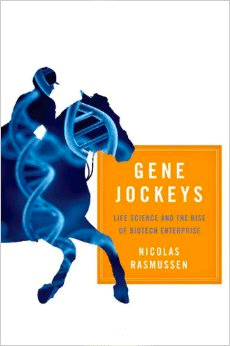By Germaine Cornelissen-Guillaume
Gene jockeys were biologists working in biotechnology firms before the term was assigned to a computer program that found the correct position of DNA sequences. Nicolas Rasmussen’s book relates how biotechnology companies emerged when basic work in molecular biology shifted toward the development of commercial products. The focus is on the development and marketing of a selection of genetically engineered drugs: human insulin, human growth hormone, alpha-interferon, erythropoietin, and tissue plasminogen activator (tPA)—five of the leading recombinant DNA drugs approved for medical use in America. As a biologist and historian of science, Rasmussen is well positioned to portray the major players in the early days of biotechnology while also providing sufficient scientific background to understand techniques underlying the fast development of molecular biology.
Relying on the scientific literature, patents, newspaper articles, corporate documents, testimony used as evidence in intellectual property disputes, and interviews, the author captures the pivotal era of the late 1970s to the early 1990s. Things were changing then, both politically and in science. Researchers were asked to pursue socially relevant projects, as federal support for basic research at universities dropped.
Paul Berg’s 1972 experiments, regarded as the advent of genetic engineering, demonstrated the possibility of mixing and matching gene segments in vitro and then moving them between living species, thus producing a biological reagent, a vehicle for growing specific genes in mammals or in bacteria. The thought of engineering recombinant bacteria to produce pharmaceuticals came not long afterwards, and by 1976 Genentech was founded to commercialize recombinant DNA technology, with plans to clone human insulin.
Rasmussen combines detailed accounts of how the science progressed with descriptions of the researchers, entrepreneurs, and other personalities behind the rise of commercial biotechnology. He argues that life scientists fostered and shaped the biotechnology sector as it emerged according to their values and interests, just as they were instrumental in drafting the NIH recombinant DNA guidelines after molecular biologists agreed to lift the moratorium in 1975. Through five case studies, the author vividly depicts the transition from curiosity-driven research to commercialization. After all, drugs such as insulin met no demand in the medical marketplace. But at least five scientists independently began projects to clone it for expression in bacteria, all at about the same time!
Highly competitive molecular biologists with high career ambitions continued to follow established research trajectories and pursue scientific credit for their achievement in cloning human growth hormone, now remembered as Genentech’s first product. Gradually, more importance was attributed to intellectual property and patent application for work now partly performed in industry, creating conflicts that led to lawsuits. Luck also played a role as FDA approval despite allergic reactions in clinical trials came when deadly cases of Creutzfeldt-Jacob disease were linked to brain-derived growth hormone.
The hype for interferon, the anticipated magic bullet against viral infections that was hoped to provide a cure for cancer, also came at a time when recombinant DNA techniques made it possible to clone it, generating the first wave of biotechnology firms. In the race for profit-making, FDA approval was granted before waiting for results from Phase III studies, despite disappointing results: Phase II trials only proved that by itself, alpha-interferon did not instantly cure all cancers. This did not prevent it from being the top selling recombinant drug of the time, keeping biotechnology firms afloat. Eventually, the drug was found to confer a modest survival benefit for patients with renal carcinoma, and was approved for use in hepatitis C. But for many patients, Rasmussen notes that interferon’s toxicity made treatment worse than no treatment. Times had also changed, and research materials were no longer freely exchanged or shared among scientists.
Erythropoietin, a glycoprotein hormone involved in red blood cell production and the wound healing process, is viewed as the most profitable and most widely used blockbuster drug produced by recombinant DNA biotechnology. Rasmussen argues, however, that this success is a mixed blessing, for the health systems that had to pay high prices for it and for the patients themselves. The extensive use of the treatment in the US indeed shortened the lives of thousands of cancer patients.
To restore blood supply during an evolving heart attack, thrombolytic treatment with streptokinase or urokinase clears the clot by activating the body’s own clot-dissolving system. With tPA, this activity appeared to occur only in the presence of fibrin, the major protein in clots. This specificity and the high cost to produce streptokinase led to yet another cloning race, with the difference that established pharmaceutical companies entered the competition. The next phase of biotech was launched, spurring research into second-generation protein drugs. With a much higher price tag, no difference in survival rate but a higher risk of stroke as compared to streptokinase, Genentech’s Activase brought financial and internal crisis to the company, and a change in management before becoming a subsidiary of Roche. Biotech’s age of innocence was over.
For each case study, Rasmussen provides a detailed and thorough account of the problem at hand, how it was solved, describing the methodological challenges facing the molecular biologists in a way scientifically literate readers will find engaging. He portrays the transition from academia to private corporations as they matured from newly formed biotech firms to big pharmaceutical companies in just two to three decades on the background of major geopolitical events that shaped society during the latter part of the 20th century. He certainly captured very exciting times, even if at the end of the day, science apart, development of biotechnology pharmaceuticals translated into business as usual. An important lesson Nicolas Rasmussen offers from a great historical perspective.
Germaine Cornelissen-Guillaume is a professor of integrative biology and physiology and director of the Halberg Chronobiology Center at the University of Minnesota, Twin Cities.




